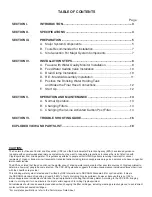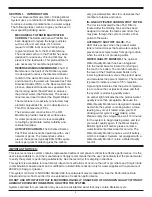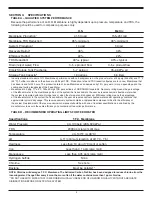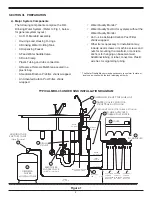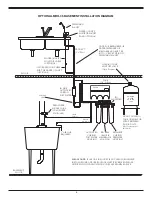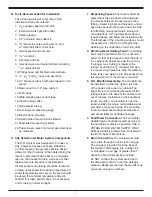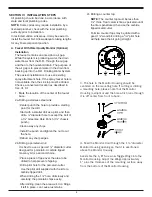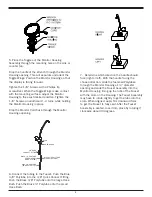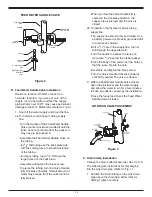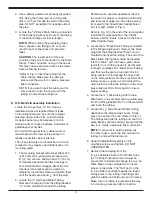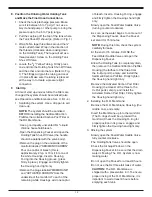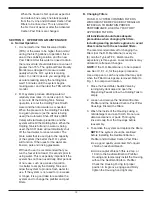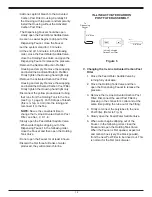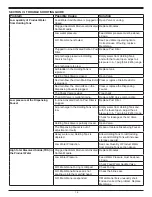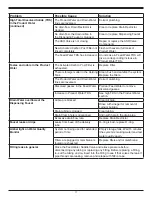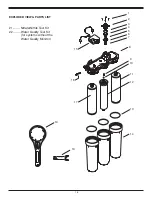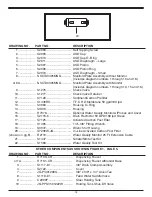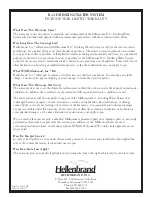
12
E. Position the Drinking Water Holding Tank
and Make the Final Hose Connections.
1. Check the tank precharge pressure. Make
sure it is between 5 to 7 psig. If not, use a
bicycle hand pump or other pump to bring the
pressure up to the 5 to 7 psig range.
2. Pull the cap/plug off the top of the tank where
the Tank Shut–Off should go. (Refer to Fig. 1)
3. Wrap Teflon tape three times around the ¼"
male outlet thread. Wrap in the direction of
the threads (clockwise when looking down
on the Holding Tank). The tape will act as a
thread sealant. Screw on the Holding Tank
Shut–Off Valve.
4. Locate the
3
/
8
" Yellow Tubing. Firmly press
one end into the Holding Tank Shut–Off Valve
and the other end into the tee. (Refer to Fig.
1) The fittings will grab the tubing and seal
it in place. Make sure the tubing is pressed
all the way in to create a pressure tight
connection.
F. Start Up
At time of start up and each time the filters are
changed the system should be sanitized (also
see Operation and Maintenance Sec. V, B.1–4).
1. Sanitizing the system. Use a drip pan to aid
clean–up.
NOTE:
The system should be sanitized
BEFORE installing the Sediment/Carbon
Prefilter, the Activated Carbon Post Filter or
the RO Membrane.
•Use a good quality unscented 5¼% liquid
chlorine household bleach.
•Open the Dispensing Faucet and open the
Holding Tank Shut–Off Valve (the handle
should be parallel with the valve body).
•Remove the plug on the underside of the
manifold labelled “SEDIMENT/CARBON”.
Pour one capful of bleach (this is
approximately 2 tsp. or 10 ml) into one of
the white Housings. Insert a Housing
O–ring into the Housing groove, (press
firmly in place). Engage and firmly tighten
the Housing hand tight only.
•Remove the plugs labelled “MEMBRANE”
and “ACTIVATED CARBON” from the
underside of the manifold. To each of the
remaining white Housings, add one capful
of bleach. Insert a Housing O–ring, engage
and firmly tighten the Housings hand tight
only.
•Slowly open the Feed Water Saddle Valve
(turning counter clockwise).
•As soon as the water begins to come out of
the Dispensing Faucet, close the Faucet.
•Let stand for 15 minutes.
NOTE:
During this time, check the system
carefully for leaks.
•At the end of 15 minutes, CLOSE the
Feed Water Saddle Valve and open the
Dispensing Faucet.
•Allow the Holding Tank to completely drain,
then remove the Sediment/Carbon Prefilter
Housing (the farthest of the three from
the In–Out ports), empty, and install the
Sediment/Carbon Prefilter. Firmly tighten
the Housing hand tight only.
•Remove the Activated Carbon Post Filter
Housing (the closest of the three to the
In–Out ports), empty, and install the
Activated Carbon Post Filter. Firmly tighten
the Housing hand tight only.
2. Installing the R.O. Membrane:
•Remove the R.O. Membrane Housing, (the
middle one), and empty.
•Insert the Membrane up into the manifold.
(The O–rings should be up toward the
manifold.) Check the Housing O–ring for
proper position in its groove, engage and
firmly tighten the Housing hand tight only.
3. Rinsing the system:
•Slowly open the Feed Water Saddle Valve
fully counter clockwise.
•The Holding Tank Valve should be open.
•Check the Air Gap Window on the
Dispensing Faucet to be sure that the drain
water is flowing. The R.O. System is now
making water.
•Do not open the Faucet for at least 8 hours.
•Do not use the first three full tanks of water.
CAUTION:
The R.O. Membrane is
shipped with a preservative in it. To ensure
proper rinsing of the R.O. Membrane, it is
important to wait at least 8 hours before
emptying each tank.
Summary of Contents for MRO-35
Page 15: ...15 NOTES ...


